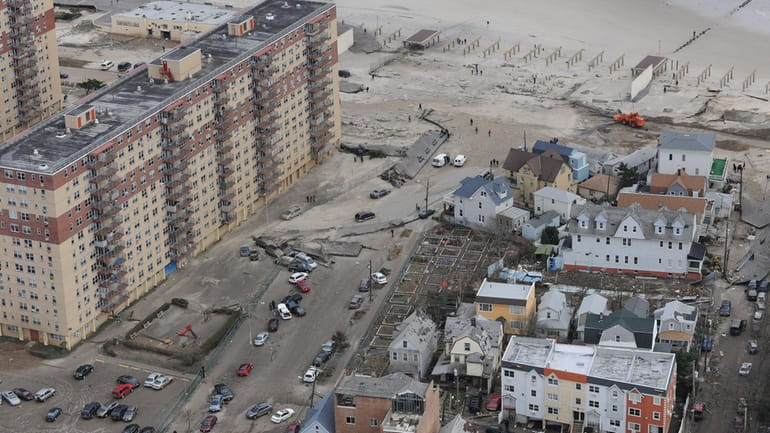Toll from Superstorm Sandy still evident on Long Island 10 years later

Thirteen people dead on Long Island. Ten billion gallons of oil, sewage and garbage washed onto lawns, into streets, into basements and then into the Atlantic Ocean. Nearly 100,000 homes, schools, businesses, government buildings and other structures taken out.
Ten years ago Saturday, on Oct. 29, 2012, Superstorm Sandy made landfall and exacted this unimaginable toll — the 100-year storm hitting the region on the precipice of hurricane season’s expected end.
“It is extraordinarily hard to believe that it’s been 10 years. It feels just like yesterday. I’m sure many of you in the community can attest to that,” Basil Seggos, commissioner of New York State’s Department of Environmental Conservation, said Friday at an oceanfront event in Rockaway, Queens, to commemorate the storm and the subsequent reconstruction. “You live through something like that once, and it sticks with you. And it becomes part of who you are, and it’s hard to turn away and see the landscape and see your community different from what it might have been that day.”
Sandy measured 1,000 miles wide, with a wind field three times the size of Hurricane Katrina in 2005. The toll in New York City: 44 dead, large areas flooded, power cut to 2.5 million residents, as well as $19 billion in damage and lost economic productivity.
On Friday, Gov. Kathy Hochul announced that a new, permanent statewide agency would aim to protect the state from the effects of climate change: the Office of Resilient Homes and Communities. She also said there would be $19 billion invested in the electric grid over 10 years to protect against “extreme weather power outages.”
In Sandy's aftermath, the Army Corps of Engineers has undertaken more than a billion dollars in projects on Long Island to avert the wrath of the next colossal storm, said the local district’s commander, Col. Matthew Luzzatto.
That includes projects in Long Beach, downtown Montauk and from Fire Island to Moriches Inlet that have been completed, and others from Fire Island to Montauk Point and the Montauk Point Lighthouse that are expected to be finished next year or the year after, according to a corps news release.
David Abramson, clinical associate professor at NYU School of Global Public Health and the lead author of a new report, “Ten Years After Superstorm Sandy: Charting a Region’s Recovery,” noted that Long Island and its people and infrastructure were walloped particularly hard.
“In New York — and this is gonna be no surprise, there were four counties that were hardest hit, even amongst those that were hardest hit -- and those were the ones that were on Long Island, including those two that are New York City-based counties on Long Island, so it was Brooklyn, Queens, Nassau and Suffolk,” he said.
He added that the levels of federal funding differed for each of the counties. Suffolk, for instance, got about $83 million in Federal Emergency Management Agency individual assistance, whereas Nassau got $336 million.
That money typically goes to homeowners and renters directly.
On the Island, notably in Nassau, there were major problems with wastewater systems and “the Long Beach area took a long time to recover.”
Based on spikes in building permits, he said, “there was a concerted effort to jumpstart building and reconstruction that was pretty much a two- to four-year process.”
Within five years, most of the major reconstruction had occurred, but “there still are some homes and some infrastructure that is still being addressed and mitigation that is obviously still occurring.”
But there apparently was more money to have been gotten from the federal government that just wasn't.
“A lot of times, people left money on the table, because they didn’t trust government; they didn’t trust contractors," he said. "And despite the efforts of government officials to help people be able to navigate these very complicated systems, people would not apply for them, and so it’s entirely possible that there’s a large proportion of people who ended up either giving up trying to get the funds that were available to them, or elected not to get them at all, because they were concerned about being ripped off — and, you know, there was some merit to those concerns.”
Thirteen people dead on Long Island. Ten billion gallons of oil, sewage and garbage washed onto lawns, into streets, into basements and then into the Atlantic Ocean. Nearly 100,000 homes, schools, businesses, government buildings and other structures taken out.
Ten years ago Saturday, on Oct. 29, 2012, Superstorm Sandy made landfall and exacted this unimaginable toll — the 100-year storm hitting the region on the precipice of hurricane season’s expected end.
“It is extraordinarily hard to believe that it’s been 10 years. It feels just like yesterday. I’m sure many of you in the community can attest to that,” Basil Seggos, commissioner of New York State’s Department of Environmental Conservation, said Friday at an oceanfront event in Rockaway, Queens, to commemorate the storm and the subsequent reconstruction. “You live through something like that once, and it sticks with you. And it becomes part of who you are, and it’s hard to turn away and see the landscape and see your community different from what it might have been that day.”
Sandy measured 1,000 miles wide, with a wind field three times the size of Hurricane Katrina in 2005. The toll in New York City: 44 dead, large areas flooded, power cut to 2.5 million residents, as well as $19 billion in damage and lost economic productivity.
On Friday, Gov. Kathy Hochul announced that a new, permanent statewide agency would aim to protect the state from the effects of climate change: the Office of Resilient Homes and Communities. She also said there would be $19 billion invested in the electric grid over 10 years to protect against “extreme weather power outages.”
In Sandy's aftermath, the Army Corps of Engineers has undertaken more than a billion dollars in projects on Long Island to avert the wrath of the next colossal storm, said the local district’s commander, Col. Matthew Luzzatto.
That includes projects in Long Beach, downtown Montauk and from Fire Island to Moriches Inlet that have been completed, and others from Fire Island to Montauk Point and the Montauk Point Lighthouse that are expected to be finished next year or the year after, according to a corps news release.
David Abramson, clinical associate professor at NYU School of Global Public Health and the lead author of a new report, “Ten Years After Superstorm Sandy: Charting a Region’s Recovery,” noted that Long Island and its people and infrastructure were walloped particularly hard.
“In New York — and this is gonna be no surprise, there were four counties that were hardest hit, even amongst those that were hardest hit -- and those were the ones that were on Long Island, including those two that are New York City-based counties on Long Island, so it was Brooklyn, Queens, Nassau and Suffolk,” he said.
He added that the levels of federal funding differed for each of the counties. Suffolk, for instance, got about $83 million in Federal Emergency Management Agency individual assistance, whereas Nassau got $336 million.
That money typically goes to homeowners and renters directly.
On the Island, notably in Nassau, there were major problems with wastewater systems and “the Long Beach area took a long time to recover.”
Based on spikes in building permits, he said, “there was a concerted effort to jumpstart building and reconstruction that was pretty much a two- to four-year process.”
Within five years, most of the major reconstruction had occurred, but “there still are some homes and some infrastructure that is still being addressed and mitigation that is obviously still occurring.”
But there apparently was more money to have been gotten from the federal government that just wasn't.
“A lot of times, people left money on the table, because they didn’t trust government; they didn’t trust contractors," he said. "And despite the efforts of government officials to help people be able to navigate these very complicated systems, people would not apply for them, and so it’s entirely possible that there’s a large proportion of people who ended up either giving up trying to get the funds that were available to them, or elected not to get them at all, because they were concerned about being ripped off — and, you know, there was some merit to those concerns.”

